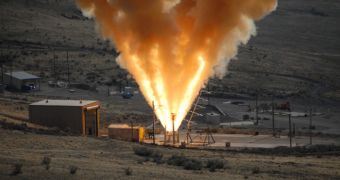A mixed team of NASA experts and technicians from their contractors has recently performed a full-scale test of the launch abort system for the future Constellation program set to replace the current space shuttles by 2015. The abort operation is aimed to save the lives of the crew of Constellation's Orion capsule by taking them to a safe distance in a blink of an eye in the case of an unfortunate accident.
Four days ago, on November 20th, the skies of Promontory, Utah were lit more brightly in the area where the Alliant Techsystems (ATK) Launch Systems facility is located. The 5.1-meter tall engine was ignited for about 5.5 seconds, burning most of the fuel during the first half of the process and delivering an amount of thrust of over half million pounds (nearly 227 tons) instantly. This is more than enough in order to carry the Orion Crew Exploration Vehicle far from the Ares I rocket.
According to a media statement given by former astronaut Charlie Precourt, the vice president of launch systems from ATK, cited by Space, "It performed extremely well. The initial data looks very good". The launch abort system manager from NASA, Barry Meredith, also eulogized ATK for "pulling together a very complex system and testing it exactly on the day they said they would".
According to Meredith, this test was "a major step forward in the development of the Orion Crew Exploration Vehicle and specifically the launch-abort system that is going to provide a safe and reliable method of moving the entire astronaut crew in the event of the emergency from the pad all the way up to [91.44 kilometers] of altitude".
The launch abort engine features an enhanced version of the design of a similar device belonging to the Apollo mission back in 1965. This one will subject the astronauts to a G-force a few times bigger than that experienced during an average launch, but it will save their lives. Following this success, the next such test to be performed next spring at New Mexico's White Sands Missile Range will involve a full-scale Orion capsule mock-up.

 14 DAY TRIAL //
14 DAY TRIAL //